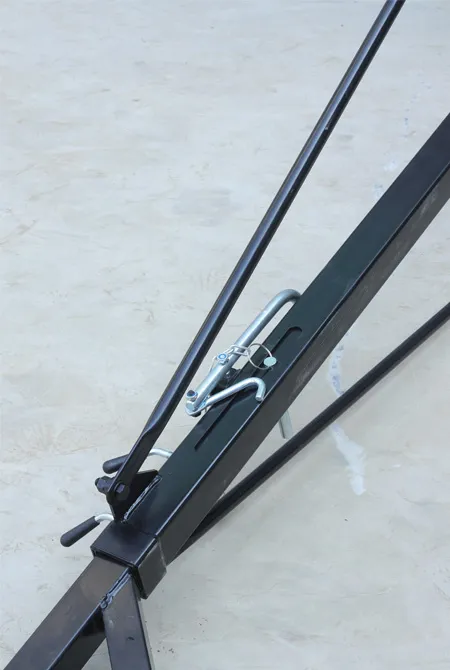mini overhead crane
Understanding Mini Overhead Cranes A Versatile Solution for Material Handling
In various industrial settings, the need for efficient material handling is paramount. Among the myriad solutions available, mini overhead cranes have emerged as a critical component, providing significant benefits in terms of space-saving, versatility, and operational efficiency. This article delves into the mechanics, benefits, and applications of mini overhead cranes, emphasizing their importance in modern industrial operations.
Overview of Mini Overhead Cranes
Mini overhead cranes, as the name suggests, are compact lifting systems designed to efficiently move materials across limited spaces. Unlike traditional overhead cranes, which are typically larger and less maneuverable, mini variants offer the same basic functionality but in a smaller, more manageable package. These cranes can be installed on a variety of structures, including warehouses, factories, and workshops, making them ideal for businesses with space constraints.
Typically operated using electric, hydraulic, or manual systems, mini overhead cranes are capable of lifting substantial weights, often ranging from a few hundred pounds to several tons, depending on the design and structural capabilities. The crane's design is characterized by a bridge that spans the area to be served, running on a set of tracks installed on a beam or the existing structure.
Key Benefits of Mini Overhead Cranes
1. Space Efficiency One of the most significant advantages of mini overhead cranes is their ability to save valuable floor space. They operate overhead, allowing for the maximum use of ground space for other operations, storage, or equipment.
2. Enhanced Productivity By streamlining the process of lifting and moving materials, mini overhead cranes contribute to improved productivity. Employees can complete tasks quicker and with less physical strain, thus enhancing workflow within an industrial environment.
3. Versatility These cranes are adaptable and can be installed in varying environments, making them suitable for numerous applications, from manufacturing to assembly lines. Moreover, they can be customized to meet specific operational needs, including different lifting capacities and configurations.
4. Safety The use of mini overhead cranes significantly increases safety in the workplace. They reduce the need for manual lifting and carrying, which can lead to workplace injuries. Additionally, modern overhead cranes come equipped with advanced safety features, such as overload protection, emergency stop buttons, and remote control functionality, ensuring safe operations.
mini overhead crane

5. Cost-Effective Investing in mini overhead cranes can be more economical compared to larger, more traditional cranes. Their reduced size often translates into lower installation costs, and they require less maintenance due to simpler mechanical systems.
Applications of Mini Overhead Cranes
Mini overhead cranes are used across various industries, including manufacturing, construction, automotive, and logistics. Some common applications include
- Assembly Lines Facilitating the assembly process by easily transporting components and parts from one station to another without disrupting operations.
- Warehouse Management Assisting in the relocation of heavy items within warehouses, making inventory management more efficient.
- Maintenance and Repair Supporting maintenance teams in lifting heavy machinery parts for repair or modification, ensuring that operations can resume quickly.
- Laboratories and Workshops Used in laboratories for manipulating delicate equipment or in workshops for lifting heavy tools and materials, thus enhancing operational efficiency.
Conclusion
Mini overhead cranes serve as an invaluable tool in today’s industrial environments, marrying efficiency with effective material handling solutions. Their space-saving design, versatility, safety features, and cost-effectiveness make them indispensable in settings where heavy lifting and movement are vital. Investing in a mini overhead crane could significantly enhance an organization's operational capabilities, leading to improved productivity and workplace safety. As industries continue to evolve, the role of mini overhead cranes is likely to expand, providing even more innovative solutions for material handling challenges.
-
Unlock Seamless Relocation with Our Heavy Equipment Moving ExpertiseNewsJun.06,2025
-
Unleash Unrivaled Flexibility with Our Adjustable Gantry CraneNewsJun.06,2025
-
Unleash Heavy-Duty Efficiency with Our Industrial Gantry Crane SolutionsNewsJun.06,2025
-
Revolutionize Steel Handling with Our Magnetic Lifter RangeNewsJun.06,2025
-
Master Equipment Mobility with Premium Machinery Mover SolutionsNewsJun.06,2025
-
Elevate Your Material Handling with Magnetic Lifter TechnologyNewsJun.06,2025
-
YS Permanent Lifting Magnets: The Smarter Way to Handle SteelNewsMay.22,2025
